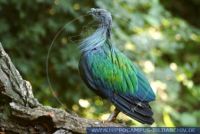Caloenas nicobarica
Nicobar Pigeon
Exif Keywords:
Exif ImageDescription:
The Nicobar Pigeon, Caloenas nicobarica is a pigeon which is a resident breeding bird on small uninhabited islands in Indonesia and the Nicobar Islands. It is the only living member of the genus Caloenas. This is a large, heavy pigeon at 40cm in length. It is mainly metallic green with green and copper hackles on the neck. The head and upper neck, flight feathers and breast are dark grey. The tail is very short and pure white. There is a black knob on the base of the bill, and the strong legs are dark red. This is not a very vocal species, but the call is a coo-coo-coo. Females are slightly smaller than males; they have a smaller bill knob, shorter hackles and browner underparts. Immature birds have a black tail. The Nicobar Pigeon roams in flocks from island to island, including inhabited sites, seeking its food of seeds, fruit and some invertebrates, and is attracted to areas where grain is available; usually, it sleeps on offshore islets where no predators occur and spends the day in areas whith better food availability. Its flight is quick, with the regular beats and an occasional sharp flick of the wings which are characteristic of pigeons in general. Peculiarly, groups tend to fly in columns or single file, not in a loose flock as most other pigeons do; the white tail seems to serve as a sort of "taillight" when crossing water at dawn or dusk. These observations are also supported by inexperienced birds, which could lead a group astray, lacking this feature. This species nests in dense forest, building a stick nest in a tree and laying one elliptical, faintly blue-tinged white egg.Source:Wikipedia
Viewed 6045 times





